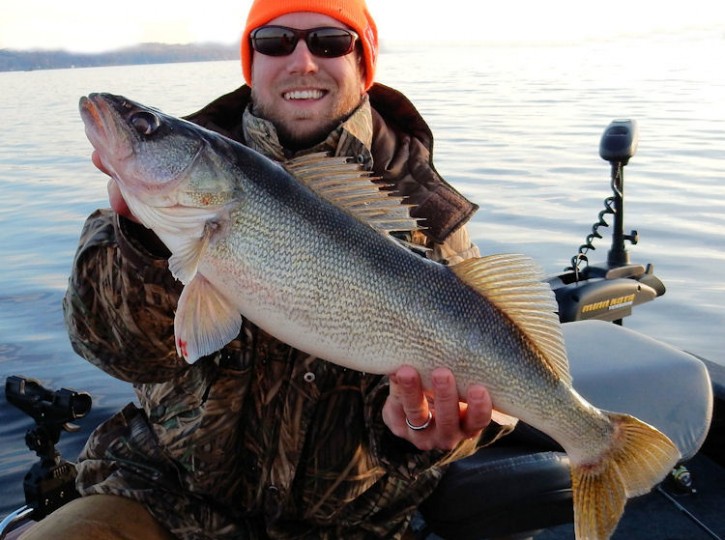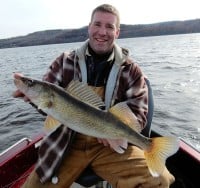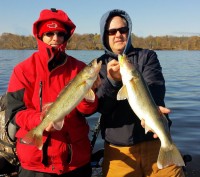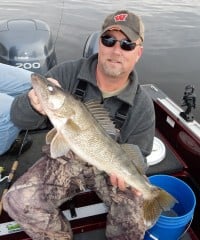It’s been a very different and interesting fall for walleye & sauger fishermen here on Lake Wisconsin. That’s not to say it was a bad one because that would not be true at all. In fact, I would venture for many of us, it will go down as one of our better falls as a whole.
Early this fall, it seemed as though there was a major lack of bait fish in the system. But as fall progressed, more and more bait fish did show up. Now it appears as though many large schools of shad stayed well inside the bays on the lake instead of out in the main lake itself. My best guess is that they did this to stay out of the current.
Lake Wisconsin rarely shows an increase in water by climbing higher up the shoreline when more water is dumped into the system via dams above the lake. (Like the Kilborn Dam located in Wisconsin Dells and others further up the Wisconsin River) What does happen is the current out in the main lake begins to move much faster through the system when more water is dumped in from the Kilborn Dam. What really affects the current out in the main lake is how much water they decide to let out at the Prairie du Sac dam located on the very bottom end of Lake Wisconsin.
When they are consistently letting out more than 10,000cfs at the Prairie du Sac dam, the lake begins to resemble a river more than a slow moving reservoir. The shad in this system appear to be more comfortable in slow or non-moving water than they are in water with current.
Another variance this fall from seasons past was that many of the saugers in particular decided to stay on the south end of the lake instead of making a fall movement towards the middle or north end of the lake. This, in my opinion, was a direct correlation to all the shad at the south end of the lake, where they elected to stay. Which leads me to ask myself: why did so many shad decide to stay on the lower end of the lake?
My very simple theory – the bay at Grubers Grove had everything the shad were looking for so there really was no need for them to move. What exactly about Grubers Grove bay was it that kept the shad there?
Number one is depth. Grubers Grove has been dredged several times over the past 10-15 years. Whereas in years past, it may have only been a couple of feet deep, it now averages anywhere from 12-18’ deep. Especially near the mouth of the bay which just so happens to be very well protected from the current out in the main lake.
Shad like to move to deeper water as the water cools in the fall. That move to deeper water puts them in a more temperature stable environment, water which is much less likely to drop a couple of degrees when those first couple of really cold nights hits. Shad, especially young of the year shad, don’t do well when water temps drop fast overnight, hence the move to deeper water is literally one of survival.
And the saugers, they simply stayed with their preferred food source.
What was more perplexing to me about this fall was the movement of big walleyes. Catches in my boat showed a distinct difference between the north and south ends of Lake Wisconsin. As already mentioned, saugers stayed on the south end of the lake and limit catches were common this fall. Walleyes on the other hand, appeared to favor the north end of the lake. I would like to add that the north end of the lake showed far fewer schools of bait fish vs the south end so it didn’t make sense to me why all those big walleyes were staying up there. But our catches during the day, showed that without a doubt, there were indeed more big walleyes and far fewer saugers under 20” on the upper end of Lake Wisconsin.
Each day out, my clients and I made the decision to target either big fish or keeper size fish. Keeper size fish run between 15-20” long whereas we defined bigger fish as slot fish over 20” long. If a full day was booked, clients had the option of targeting big fish in the morning and keepers in the afternoon, or vice/versa, which usually worked out pretty well.
But that question of why so many bigger fish on the upper end kept popping up in the back of my head. I’ve always felt that big walleyes tend to feed primarily at night. Not that they won’t feed during the day but for that to happen, the conditions have to be right. Cloudy, windy, rainy…all definitely seem to make for a better day bite when targeting big walleyes. Granted, they also tend to lead to a better bite from all fish in general.
A quick note on technique: All the fish we caught during our day trips this year fell to a jig of some sort and few to blade baits, especially during the last two weeks of our season. By far though, most of our fish were caught on jigs tipped with moxi’s from B’Fish’N Tackle. We did use a few paddle tails toward the end but for the most part, the decision on which plastic to put on our jigs was between a 4” or 3” moxi and which color. Top colors by far were chart/pepper and chart/orange core.
To answer my own suspicion that big walleyes feed primarily at night, I vowed to get out and test a few theories. A couple friends and I did indeed do a little bit of that and I hope to post a report soon about our night fishing adventures on Lake Wisconsin.




I couldn’t buy a bite on chartreuse orange core this fall. Hair jigs in chartreuse and orange, however, caught a few for me. It is interesting how one color works so well for one boat and not so well for another. Chartreuse green core was the color this weekend, not one bight on chartreuse pepper. I look forward to the night report!
My last couple trips, it was all orange core for my boat. I tried most other colors, and all caught fish, but the orange core was by far the best for me over the last few weeks. Orange hair was also a strong producer as were flies in pink/purple and natural colors like brown/grey or silver/white.
Nice fish Joel! made it out there this fall myself for the first time. Got some nice little eaters, but no quality like you have. Great job dialing that in!
Thanks for sharing your insight about this great body of water. This fall was my best fishing on L WI having been pointed in the right direction by you and John……south. I’m sad it ended so abruptly with this blast of unseasonably cold weather prematurely locking up the lake.
Chartreuse Pepper ringworm, 3” grub or BFishN paddletail the most consistent producer. Early AM or overcast sky Electric Blue aka BFishN Fire and Ice with Chartreuse tail or pearl tail did a lot of damage.
I to experimented with 3 way and streamer flies getting fish on Chartreuse/pearl mylar, Kelly Green/light Green/mylar and best was Fuscia/Red/Mylar. One day my last 5 of 7 fish came on that fly. I tie them with Fun Fur same as my hair jigs, adding 6 to 8 strands of banded pearl mylar and trim to about 2.5”. I was getting bit more often on the jig/plastic so didn’t seem like the fly affected that presentation. Likely I will continue to use the 3 way setup in the future in non-snaggy areas. Re-tying 5 knots vs one can really cut into fishing time. I’ve gone to pre-tying a few and storing individually in small zip lock bags.
It doesn’t make sense how this isn’t a good ice fishing lake. I have been out there about three times trying different spots. I know there is fish just doesn’t make any sense.